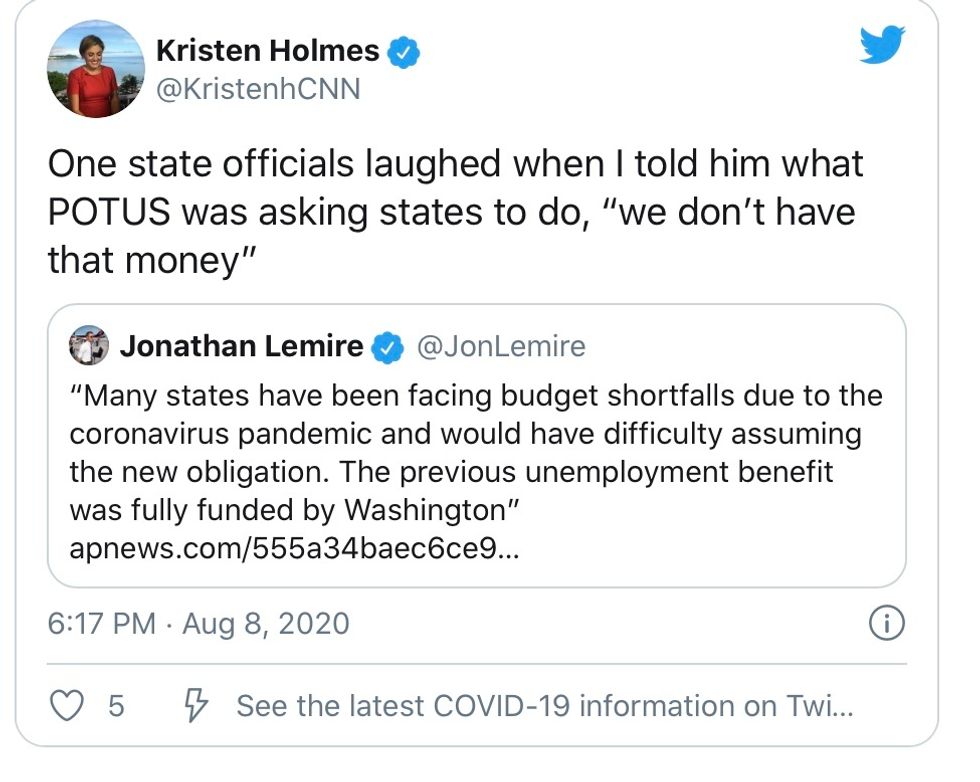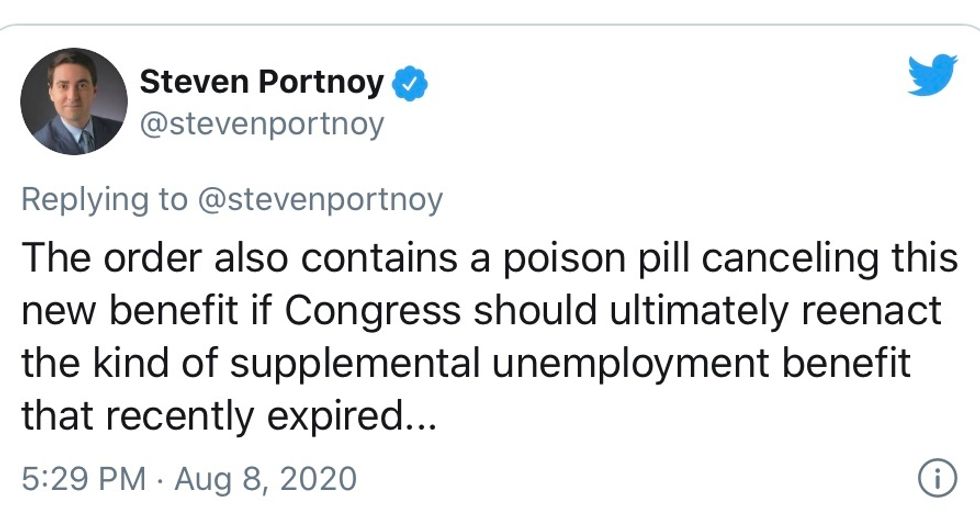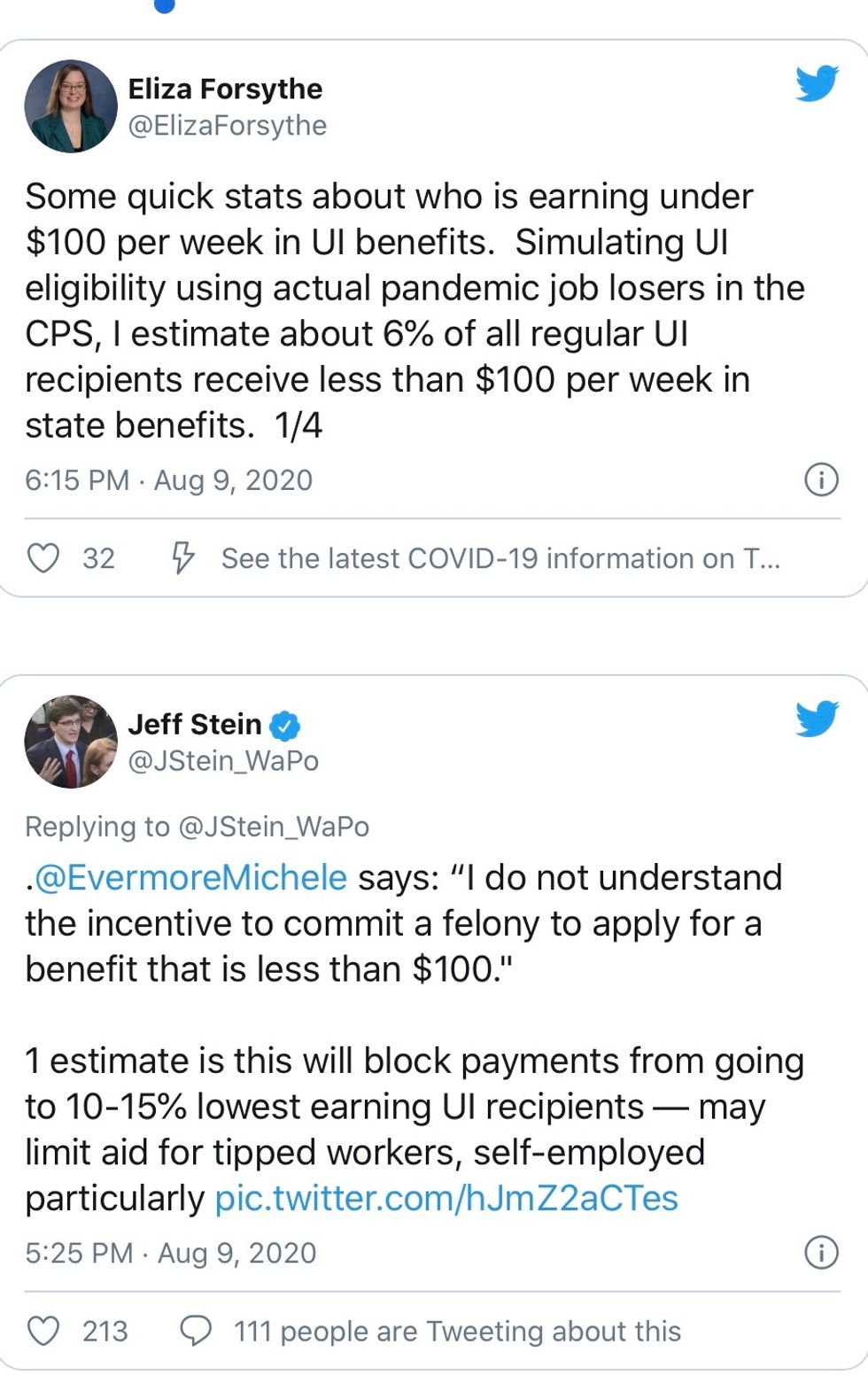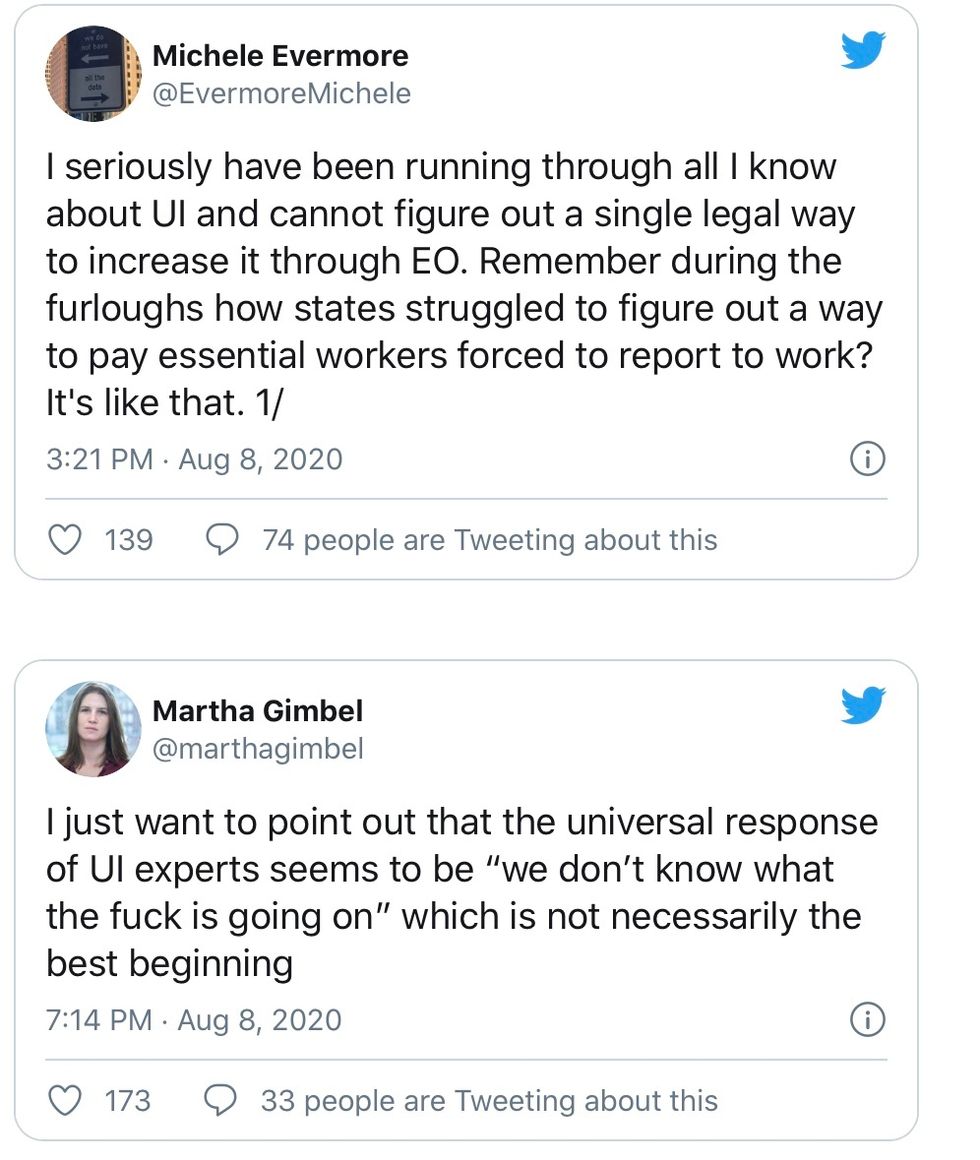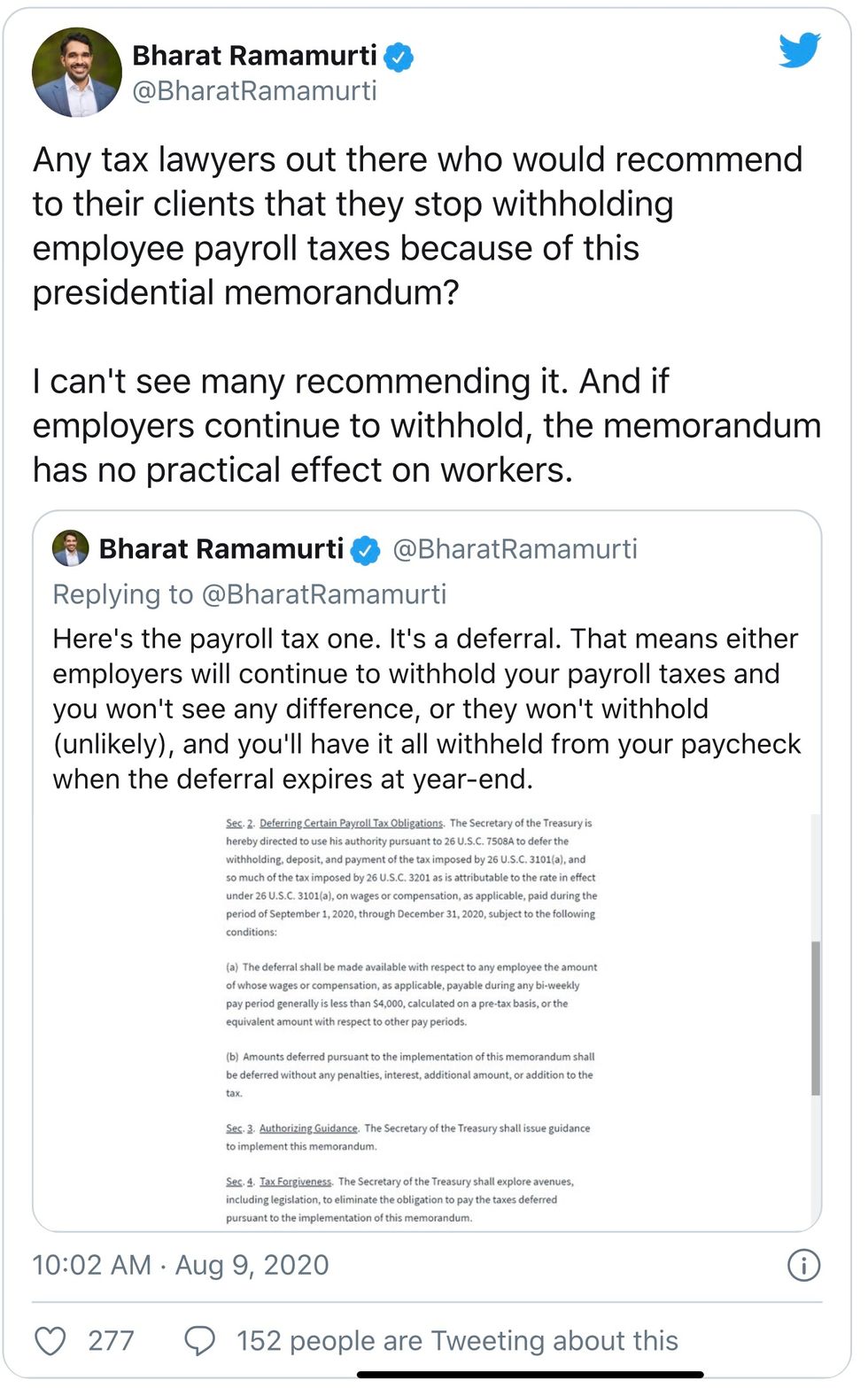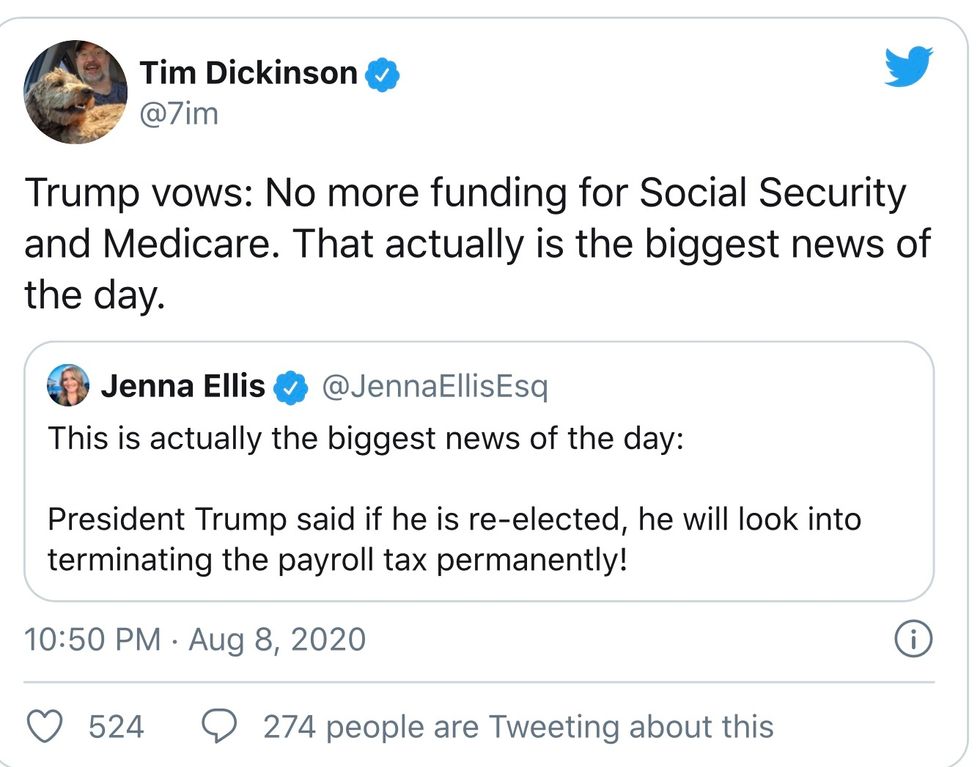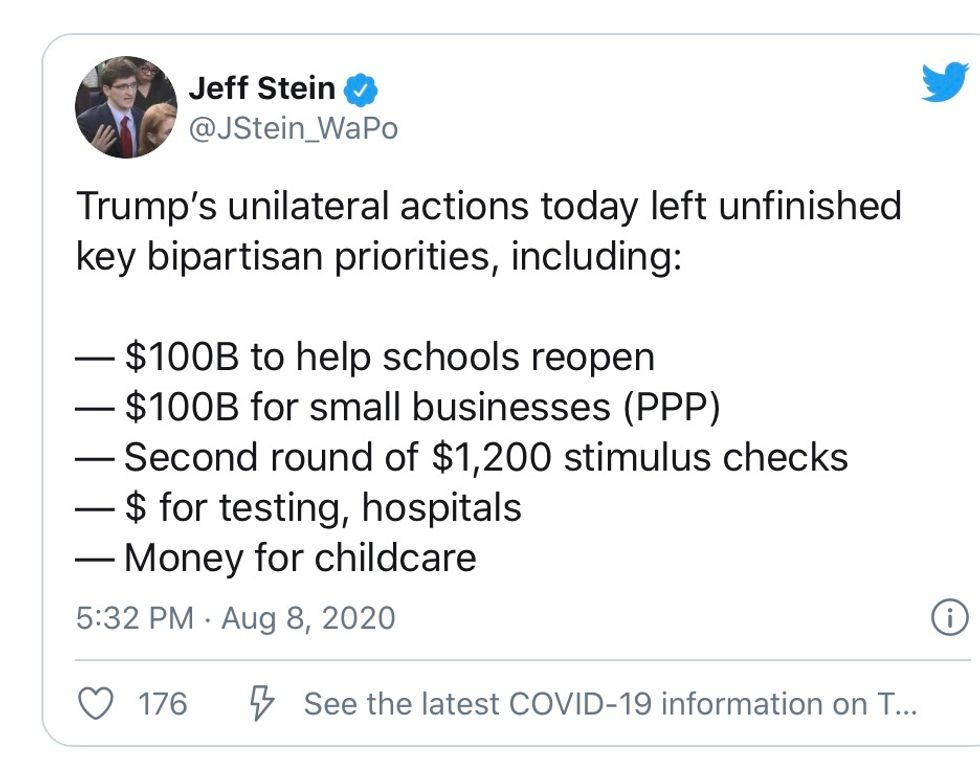President Trump signed four executive actions on Saturday in which he attempted to bypass Congress (and the Constitution) for what he sold as a bold effort to extend relief for Americans suffering under the COVID-19 pandemic, after Congress was unable to reach a deal on an extension or reinvention of the CARES Act. Trump's measures, at least as he presented them, addressed unemployment assistance, an eviction moratorium, student loan relief, and the deferment of payroll taxes. But even if they can be legally or logistically implemented — let alone fully implemented — Trump's proposals fall far short of what the CARES Act provided and what most economists believe is necessary, and could instead lead to brand new problems. The measures will face serious, substantive legal challenges, and with the exception of the student loan action, are unlikely to deliver a timely real-world impact for Americans facing economic hardships due to the pandemic.
Trump's proposals, as written, also fall short of what he said they would do when he announced them. The president even mischaracterized what the measures technically were: On Saturday he called them "bills," which they were not, nor were they all executive orders, as Trump had repeatedly said they would be. Three were actually memorandums, which carry less legal weight — undoubtedly by necessity.
All of this is par for the course when it comes to symbolic proclamations from the president, who regularly prefers political theater to political action or policy substance, but in this case, smoke and mirrors are an especially egregious response to what was already a raging economic wildfire.
Below is what we know about the executive actions, the death that's in the details, and what some of the reaction has been.
Federal unemployment assistance that passes the buck to states
The CARES Act provided $600 a week in federally-funded unemployment assistance to roughly 31 million Americans, on top of standard state unemployment benefits, which average roughly $330 a week nationwide. Those benefits expired on July 31, and Trump's new memorandum attempts to revive them while cutting the federally funded contribution to $300. The president said that the total will be $400, but only $300 would come from the federal government. The remaining $100 is supposed to come from states, many of which are already facing serious fiscal crises thanks to pandemic and have already been begging the federal government for more money — not an opportunity to come up with more money they don't have.
According to the memorandum, states can pull funding for the assistance from relief funds provided by the CARES Act, but many states have already allocated most or all of that money. The memorandum also necessitates setting up a brand new "lost wages assistance" program to deliver the aid instead of using the traditional unemployment system. Setting up a new program would most likely take months for states to do, and many states already had significant problems figuring out how deliver the CARES Act assistance earlier this year. Now they'll have to set up another one. If they don't, or can't afford to, then residents of those states will not receive the extra unemployment assistance. That doesn't just pass the buck, it tries to pass the political cost of the missing benefits onto state leaders.
When Trump was asked on Saturday how many governors he expected to sign up for the program, he replied, "If they don't, they don't — that's up to them," which echoes Trump's ongoing stance on the federal government's pandemic response. On Sunday, he and White House officials suggestedthey might waive individual states' responsibilities for the $100 cut, but plenty of other problems remain even if that idea is ever fully baked.
And there is another catch: This federal aid will be available to states that sign on until December 6 — or until the roughly $44 billion in allocated funding runs out, which experts say would likely happen in less than six weeks. Furthermore:
The funding itself is another issue. Trump's memorandum says that the $44 billion is supposed to come from FEMA's disaster relief fund, which currently contains about $80 billion. That reallocation may not even be legal without Congressional authorization, which lawsuits will soon seek to point out. As constitutional law expert David Super explained to the Washington Post, "The basic notion here is the president is rejecting Congress's power of the purse. That is something nobody who cares about separation of powers can let slide, even if they like what the money is being spent on."
It's also not clear what impact diverting funds from FEMA would have should this year's hurricane or wildfire seasons ultimately prove extra disastrous. (And the NOAA has made some dire predictions on that bad-weather front.)
Finally, jobless Americans who are lucky enough to live in a state that can sign on to the program will only qualify if they already get $100 or more in existing state unemployment benefits — which effectively means the assistance was designed so that it would not be available to the poorest Americans.
Meanwhile, the response from unemployment insurance experts has been a mixture of shock and horror.
On top of all that, the White House's attempt to sell the plan on Sunday inspired more confusion than confidence:
This is a White House executive action; Kudlow is the President's chief economic adviser, and he runs the policy pr… https://t.co/xSlv6l3kSn— Justin Wolfers (@Justin Wolfers) 1597004377.0
A Potemkin order on eviction protections
Trump's sole executive order of the four measures on Saturday was supposed to help the 40 million Americans potentially facing eviction, which the order does not actually do. The president did not even try to renew the federal eviction moratorium or use his other federal powers to help renters. His executive order was more of an executive ask, as Heather Long explained at the Washington Post on Sunday:
Instead, Trump calls for Health and Human Services Secretary Alex Azar and Centers for Disease Control and Prevention Director Robert Redfield to "consider" whether an eviction ban is needed. Trump also didn't provide any more money to help renters. The executive order calls only for Treasury Secretary Steven Mnuchin and Housing and Urban Development Secretary Ben Carson to see if they can find any more funds to help out. It doesn't promise more aid.
Many housing advocates and landlords were surprised Trump didn't do more to help renters. The federal government owns the vast majority of mortgages in the nation through Fannie Mae, Freddie Mac and other entities. Back in March, Congress passed a federal moratorium preventing many evictions, but it expired on July 24. That moratorium covered all renters living in places that had a federally owned mortgage. Many thought Trump likely did have the authority to extend at least that eviction ban, but he did chose not to do so.
A risky payroll tax deferment nobody even wanted that cuts funding for Social Security
First off, the Trump's memorandum did not cut payroll taxes, as the president has long called for, and as he falsely claimed the memorandum did when he announced it on Saturday. Instead, if implemented, the memorandum temporarily defers the collection of payroll taxes for workers making less than $104,000 until the end of the year — a measure which has drawn bipartisan opposition in Congress. (Previous payroll tax measures have not paid off politically, either.)
Qualifying workers will still owe those taxes, which means they would need to save that money, which many will not be willing or able to do. In addition, many, if not most, employers may not even go along with the deferral, but may instead elect to continue to withhold the money from employees anyway. And only large corporations may have the financial flexibility to somehow turn the deferment to their advantage. Most likely, as Bloomberg explained on Sunday, employers will proceed cautiously, if at all:
If Congress doesn't ultimately cancel the amounts due and not paid in 2020, they could be on the hook to pay the Treasury next year. …
If firms pass on the temporary savings to their staff, they could face difficulties clawing back the money in 2021 – all the more so if some workers have moved on. And any move to continue collecting the fees could mean tensions with employees whose household incomes have already been hit by the coronavirus pandemic.
Employees would also owe more income taxes because their wages would be higher, meaning that some could see a smaller tax refund in 2021 – or owe money to the government – if they don't adjust their IRS withholding.
The deferment also targets Social Security, since that's what payroll taxes fund (along with part of the Medicaid program) and many have criticizedthe deferment as an attempt to defund the safety net.
So what was the point? Trump made it clear on Saturday that he was trying to give workers a temporary loan which they won't have to pay back, so long as they vote for him this fall. "If I'm victorious, [on] November 3, I plan to forgive these taxes and make permanent cuts to the payroll tax and to make them more permanent," he said, though he can't legally follow through without Congress. What he can do, in the meantime, is try to frame Joe Biden as some kind of loan shark who will want the money back.
Continued temporary student loan relief until the end of year
Since managing student loans are entirely the prerogative of the federal government, this is the one executive action that Trump ordered which definitely does something, legally. Trump's memorandum directs the Department of Education to extend, by three months, the student loan relief implemented by the CARES Act, which suspended interest and paused loan payments on federally-held student loans until September 30. So Trump's directive means those benefits have now been extended until the end of the year. Neither the CARES Act nor Trump's memorandum included relief for privately-held student loans.
That all being said, the move will still lead to problems, as Politico's Michael Stratford pointed out on Saturday:
The president's executive action will likely prove complicated for the Education Department and the companies hired to implement the policy in the coming weeks.
The CARES Act, for example, requires the department to send out notices to borrowers about the Sept. 30 expiration of benefits. The department had been preparing to begin sending those warnings as early as next week, and it is unclear whether the administration has the authority to halt them.
The mishmash of student loan relief provided through Congress and executive action could also create challenges in implementing the freeze on payments and interest.
What Trump's executive actions don't address
Inadequate unemployment benefits, the threat of evictions, and student loan relief were hardly the only economic issues that need to be addressed amid the COVID-19 pandemic — and Trump's executive actions won't do anything about them.
So what comes next?
Lawsuits, more empty posturing from the president and his allies, bad-faith calls for Joe Biden to pledge to forgive the payroll taxes Trump is trying to defer — and little hope of further assistance for struggling Americans until Congress passes another stimulus. Some Senate Republican leaders have praised Trump's new actions, but more for their symbolism than substance. It's possible, of course, that the president is launching his so-called orders to spur Congress to act, but as the Los Angeles Times noted on Saturday — Trump probably doesn't have anywhere near as much leverage as he thinks he does:
One person familiar with the White House's thinking on the matter suggested that Trump is trying to pressure Democrats to make concessions in negotiations with White House Chief of Staff Mark Meadows and Treasury Secretary Steven T. Mnuchin. But the president's zigzagging on legislative matters, his constant catcalls from the sidelines and his diminished political standing have left him with a weaker hand to play.
"When you've got administration officials on the hill trying to negotiate the next round of COVID relief and he's on the golf course tweeting about a payroll tax cut — completely disengaged and not remotely connected to the conversations his own people are having with congressional leaders — that's a bystander in chief," said Michael Steel, a former top aide to John A. Boehner, the Ohio Republican who served as House speaker from 2011 to 2015.
Trump claimed on Sunday that Democrats were now "more inclined" to make a deal because of his orders. He and his allies have also been gleefully daring anyone to challenge his new executive actions in court, suggesting they will face the wrath of voters for appearing to stand in the way of more federal assistance. Thus far, polls indicate that voters have not fallen for Trump's pandemic theatrics. They may not agree with Trump's new less-is-enough proclamations, either.
Chas Danner, New York Mag, August 9, 2020
###
August 10, 2020
Voices4America.. Post Script. This is a full summary of what Trump's largely unconstitutional orders do, imply and don't do. Yes, he ends funding for Soc.Sec./Medicaid. The good news is that voters are not fooled by #TrumpDemagoguery #Biden2020 Share this!

